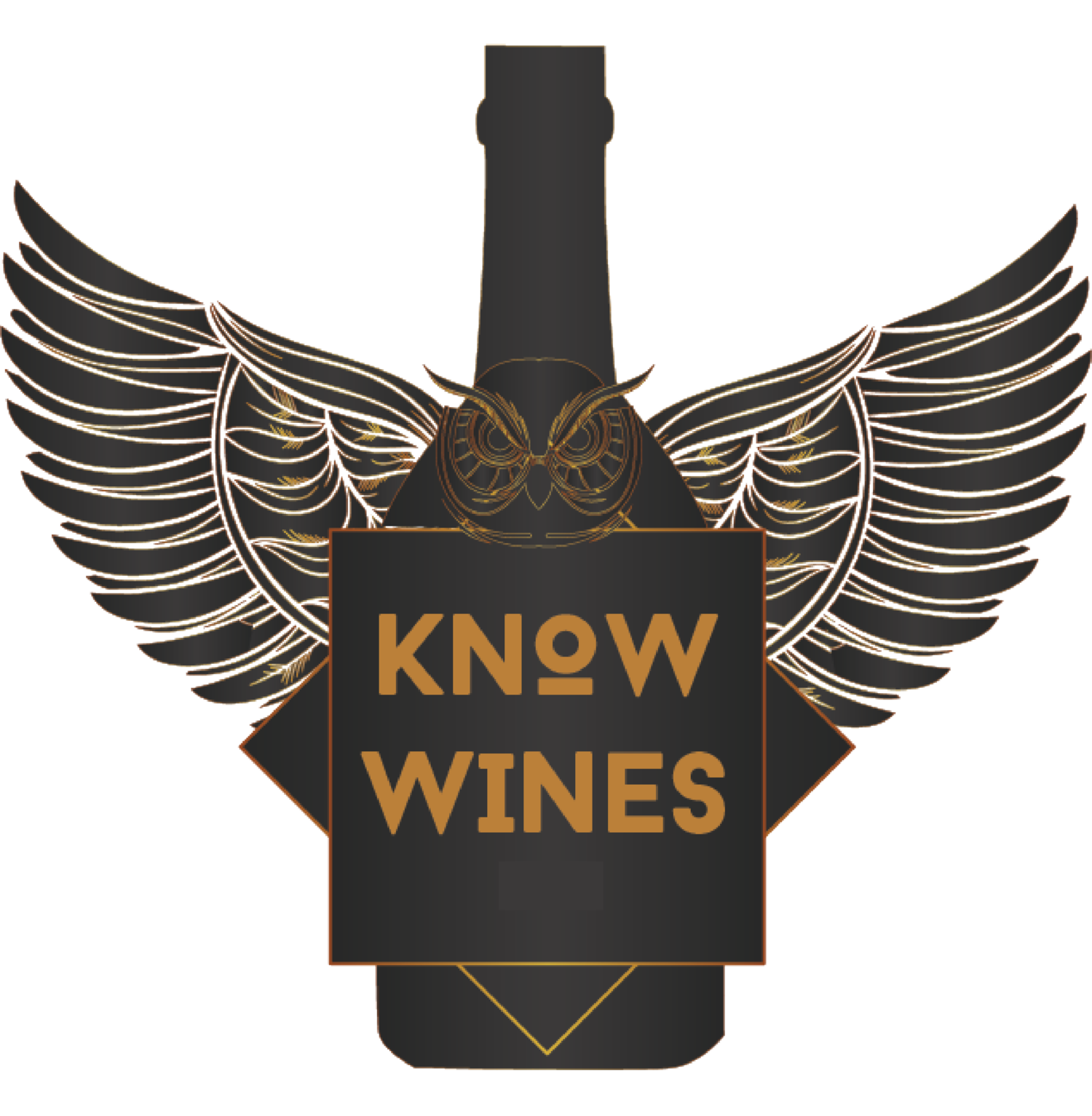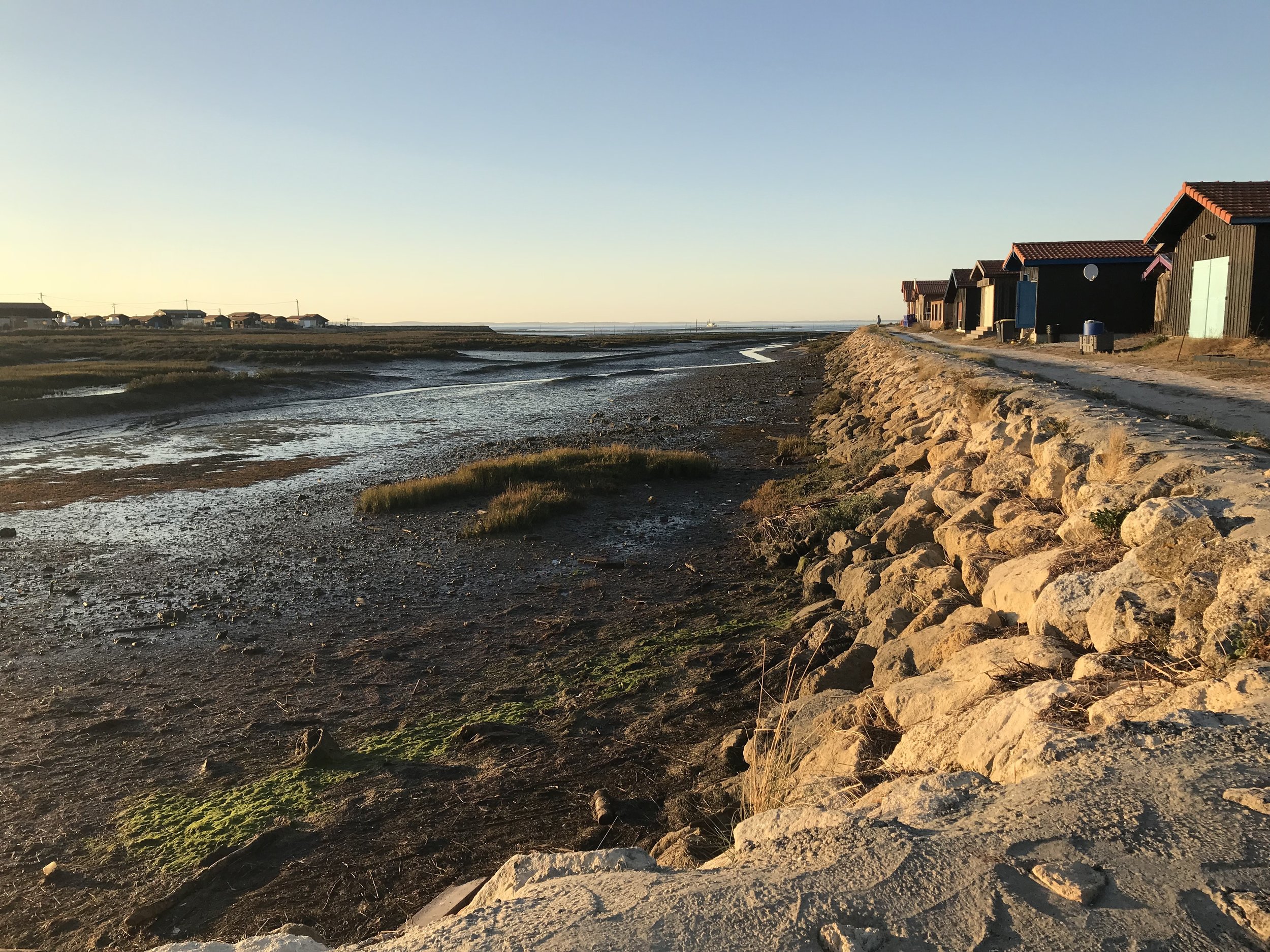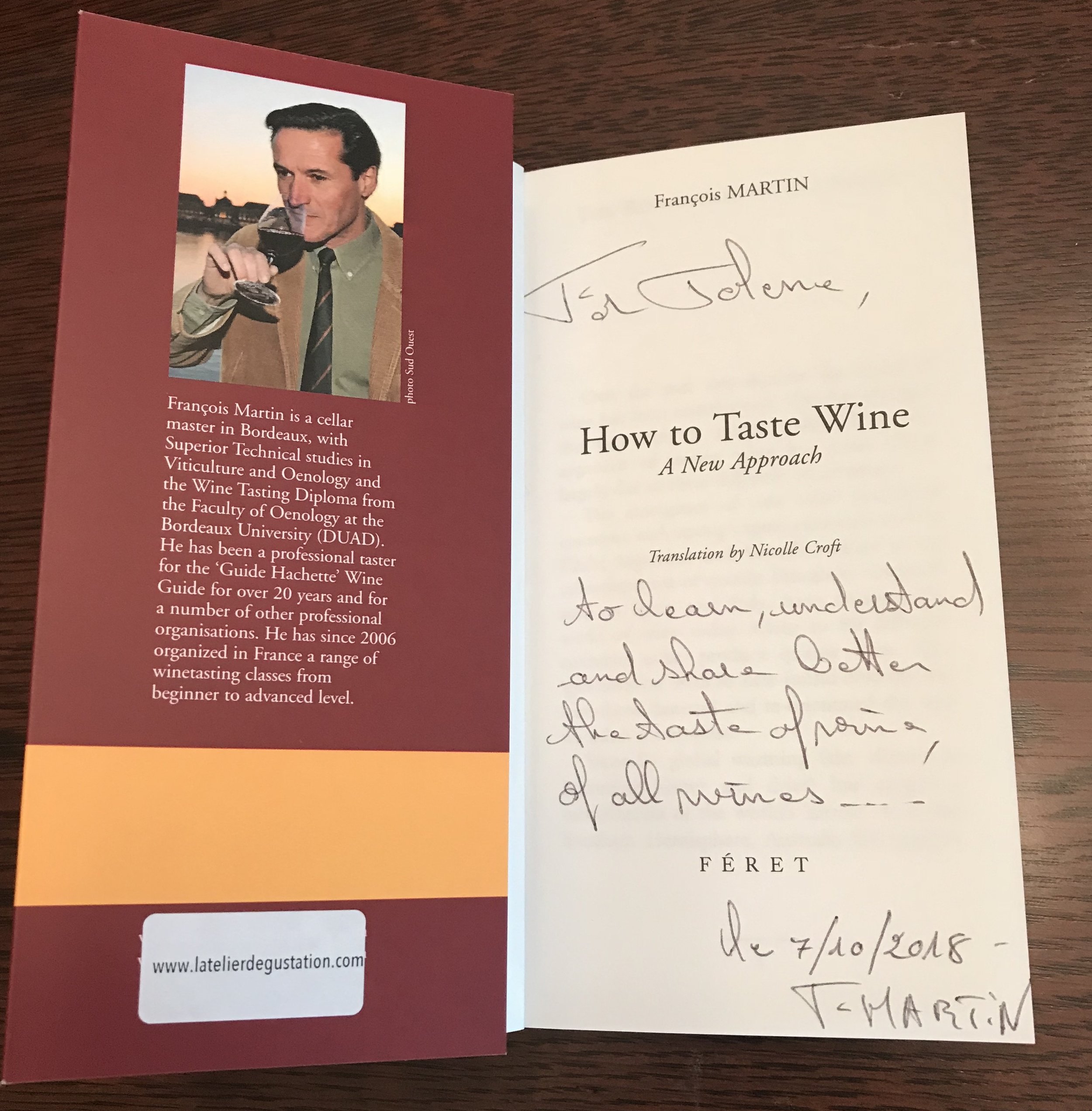In early October, Jolene headed to Bordeaux to visit small and independent grape growers and winemakers, village bottle shops, fisheries, and oyster farms. Historically, much of the stateside marketing for travel in this region in directed towards older, male audiences and with an emphasis on the pursuit of “trophy wines.” Jolene, a forty-something Durhamite and female entrepreneur, was proud to buck that marketing trend by enjoying the region as a solo traveler. Not only did Jolene plan her entire trip to Bordeaux, she wrote a travel guide while she was there. Jolene’s mini travel journal, posted as this month’s blog, can serve as your own personal guide to Bordeaux. We hope Jolene’s experience will start a trend of women setting out on solo adventures to one of the world’s greatest wine regions.
Day One: Bordeaux by Foot
There are two good options for getting to Bordeaux from other French cities. First, the high-speed train service from CDG (Paris) to Bordeaux, and second, the nonstop morning and evening flights on airlines such as Air France from cities like Lille, Lyon, Düsseldorf.
In Bordeaux, there are several hotel options and gîtes (rental apartments or homes). I’ve stayed both downtown and near the train station. Staying downtown comes with accessibility. You can walk or Uber easily to almost anywhere in the city. No matter where you stay, skip renting a car. Not only is parking very hard to find, Bordeaux is one of the easiest cities in France to navigate by foot, Uber, taxi, or train. As a solo female traveller, I felt perfectly safe walking around on the well-lit streets (however I might avoid walking around the train station at night as there is some prostitution and drug traffic there). The first weekend of each month, the entire downtown is closed off to automotive traffic which makes it a great time for exploring by foot.
Day Two: Arcachon Bay
Gujan-Mestras oyster huts
Arcachon is a small city on a bay well known for oyster farming. Though the train I planned to take wasn’t running, the hotel set me up with a driver (by the name of Roger) to take me to the bay. After a lovely lunch at Le Patio, I walked seven miles around the West Salt Meadows and visited the the oyster farming capital of Arcachon Bay, Gujan-Mestras. This village has an Oyster Museum (Maison de l’Huître) where you can learn all about farming methods, then step outside into the port to see small oyster huts that house the equipment necessary for growing oysters (it takes 3-4 years between the time an oyster is “born” until it is ready to be harvested for consumption!). Near the huts, one can taste oysters at several outdoor restaurants while watching the sun set. At day’s end, the train still wasn’t running, so I messaged Roger for ride home.
Day Three: The Village of Saint-Émilion
ETS Martin Wine Store
On past visits to Bordeaux, I visited the village of Saint-Émilion and worked with a wineseller named Emma from the wine shop, ETS Martin. ETS Martin uses the Durham-based Queen of Wines importer, so my purchases last year were seamless. Before my visit this year, Emma sent me her entire inventory via PDF. This seller, like several others in this quaint village, specialize in wines across the spectrum — blue-chip wines for investment, ready to drink aged wines, and wines from small vignerons. After tasting and spitting about forty wines, I walked up the street and enjoyed a long lunch at Hostellerie de Plaisance. The menu there featured items from the region, including pigeon and locally made cheeses and wines. Then, I went back to ETS, placed my order with Emma, and walked around Saint-Émilion and the surrounding vineyards. When Roger picked me up at the end of the day, he gave me a box of Macarons made in Saint-Émilion. Perfection!
Day Four: From Museum to Market
I’d planned to visit the hipster area of Bordeaux, to see urban gardening and take a graffiti tour, but it was raining quite heavily. So, I changed my plans and visited the La Cité du Vin, a museum of wine culture and civilization in Bordeaux. The museum is less than two years old. The first floor includes a bottle shop with wines from all over the world, as well as a cafe where you can taste wines with cheese and charcuterie. The second floor has a wine book library and a theater where wine classes are held in French and English. Another floor houses interactive visits for children and adults. Some of the exhibits include wine aromas, touching objects that simulate the textures of wine, light displays to teach the colors of wines and wines as they age, and 3-D holograms detailing the history of winemaking and important moments in civilization that impacted wines and vines. There’s also a nice restaurant with panoramic views of Bordeaux on the seventh floor. At the end of the tour, you get a free glass of wine!
Francois Martin book
After the museum, I walked across the street to have lunch at a new food hall called Les Halles Bacalan, an indoor food market much like the Raleigh Farmers Market hall. Foods available for purchase included seafood and oysters, cheeses, charcuterie, truffles, fresh pasta, pate, desserts, and fresh fruits and vegetables of the region. There’s also a wine bar and restaurant.
That evening I had a wine tasting with author and former cellar master François Martin in his wine tasting salon. At the end of the tasting, he personalized a copy of his wine tasting book for me!
Day Five: SIP Wine Tours in Graves / Sauternes
This is the day I began a wine tour to Graves/Sauternes with Veronica Wells of SIP Wine Tours, a woman-owned small business started by Nicolle Croft highlighting small producers and off-the-beaten-path wineries. Veronica has a WSET Diploma and teaches WSET Level 2 and 3 in Bordeaux. Veronica picked me up from my hotel on Days Five and Six for my own personal wine tour.
Wine tours are a fairly new phenomenon in Bordeaux. Historically, the Châteaux were closed to the public, with tours available only to wine business insiders, the merchant class, nobility, and statesmen. In the past five years or so, the Châteaux have really opened their doors. There are over 7,000 Châteaux in Bordeaux. I chose the Graves, Pessac-Léognan, Sauternes, and Barsac area of Bordeaux for my tour because it is a region often overlooked by wine tourism. Going back in history, the top wines in the world were sweet wines (this includes Champagne, late harvest wines from the Mosel and Sauternes). Now, dry red wines are the global trend. It costs about the same for winemakers to make the sweet, botrytized wines of Sauternes and Barsac as it does for the top Château to make dry red wines, so I had to visit and support these “underdogs.”
Here’s a run-down of our Day Five Châteaux:
Château Guiraud near Sauternes. In 2011 it was the First Grand Cru Classé to be awarded Organic Agriculture certification. This property is owned by a consortium of investors. About 85 hectares (210 acres) are in the Sauternes appellation, and are planted with Semillon and Sauvignon Blanc. Many investments have been made in the property that was once known as Château Bayle. They have an updated tourism center (unusual for Bordeaux, as they’ve been offering tours for 30 years) and have invested heavily in planting gardens, creating windbreaks, and converting their agriculture practices from conventional to organic which took them over ten years. In early 2018, they opened a restaurant called La Chapelle featuring regional cuisine. After our tour of the grounds, which included the vineyards, gardens, renovated drainage system, and winemaking facilities, we tasted the 2015 Château Guiraud Bordeaux Blanc dry white wine, their 2014 Petit Guiraud sweet white, and the Château Guiraud 2010 and 1996. The 1996 was my favorite.
We learned on our tour that a summer hailstorm at Château Guiraud damaged many of the grapes and vines. Photos from the storm show mountains of hail that look like snow! Likely, this Château will have no harvest in 2018. Hail damage to the vine can also impact next year’s vintage if the damage to the vine is severe.
Vertical Press at Chateau Haut-Bergeron
Château Haut-Bergeron near Preignac. Caroline Jeanpierre took us on a tour of this small winery, owned by the Lamonthe family since the mid-19th century. They have about 17 hectares (42 acres) and produce about 30,000 bottles per year. They grow Semillon, Sauvignon Blanc, and Muscadelle grapes on many parcels. We toured the winery at the middle of harvest and witnessed how they press their grapes, first with a pneumatic press, then with a vertical press. We met the winemaker and tasted the pressed fruit before it started to ferment. We also tasted some post-fermentation wine that had just been placed in oak barrels, where it will age for 18 months. Since they harvest rather late, the wines are very rich, and the price of the wine is very reasonable. An importer from Raleigh was at this winery during this same week in October, so we might see their wines pop up soon in local restaurants or bottle shops!
Château Haut-BaillyGraves Grand Cru Classé Pessac-Léognan. I’ve heard that in the case of not-so-good Bordeaux vintages in the Médoc, wine lovers look to Graves as their backup plan. I asked for a tour of a Châteaux that featured both highly sought after wines of Graves and some interesting soils. Château Haut-Bailly sits atop the gentle slopes of the Graves region. This region is the birthplace of grape growing in Bordeaux, with documentation going back to 1461 showing that this site was excellent for cultivating vines. The gravels are full of the petrified remains of fossilized shells on top of sandstone.
The winery prides itself in combining this long history with technology and innovation. Each subplot in the vineyard is harvested and fermented one by one. I got to taste some wine undergoing fermentation after the winemaker tested specific gravity. In the vineyard, Massal selection (or, the French term for selecting the best vines and propagating them through cuttings) is used to create genetic diversity in the vineyard. In addition to technical innovation in the vineyard and cellar, the technical director of Haut-Bailly participates in several research groups and works closely with Bordeaux University to ensure that the next generation of winemakers is coming up through the ranks.
In the beautiful tasting room we tasted the Château Haut-Bailly 2014 and their second wine, La Parde Haut-Bailly. The Château Haut-Bailly was my favorite — a blend of Cabernet Sauvignon, Merlot, Petit Verdot, and Cabernet Franc.
Day Six: Graves/Sauternes, Continued
Chateau Malartic-Lagraviere Gravel
Château Malartic-Lagravière, classified as Cru Classé for red and white wine in the Pessac-Léognan appellation. Again, I wanted to see some different types of grapes growing throughout the region. This vineyard is located on top of a gravel croup (plateau) right on the outskirts of Bordeaux and has an iron-rich sandstone. Inside the winery, when one goes from the receiving area to the cellars, the walls are lined with soil samples highlighting the composition of the soil. This was a great place for the agronomist in me to geek out! It was in this winery, too, that we got to see the pumping over process. The winery makes both dry red wine (Cabernet Sauvignon, Merlot, Cabernet Franc, Petit Verdot) and dry white wine (Sauvignon Blanc and Semillon). The winery is family-owned by a Belgian businessman.
Château Doisy-Daëne in the commune of Barsac and classified in the original Bordeaux Classification of 1855 as Second Cru Classé. This Château is very special. It’s winemaker was Denis Dubourdieu, who was nicknamed “The Pope of Wine.” He was also a professor of oenology at the University of Bordeaux and director of the Institute of Vine and Wine Sciences of the University of Bordeaux. His area of expertise was white wine making. His list of innovations in the region since the 1960’s included organic farming, oak barrel fermentation, and improved bottling techniques for white wine. Denis Dubourdieu was named 2016 Decanter Man of the Year shortly before he passed away later that year.
Winemaker Jean-Jacques Dubourdieu shows us the stages of botrytis infestation.
Our tour guide was Jean-Jacques, one of Denis’ two sons. Jean-Jacques introduced us to his grandfather, who is in his 80s and still lives at the Château. The winery is trying to establish some bee hives, but unfortunately parasitic wasps were carrying away the worker bees (so we stopped the tour briefly to kill some wasps!). We tasted sweet wine from a barrel using a wine thief (a small pipe used to remove small amounts of wine from a cask in order to taste or test it). Jean-Jacques also showed us how the botrytized grapes are stored before crushing (in a refrigerated bunker) and he walked us through the botrytis life cycle. Even though this small estate was in the middle of harvest, they took the time to show potential customers how they do what they do, which was quite amazing! We also tasted through all their wines, which are available by order from Total Wines. Before we left, Jean-Jacques was searching through several boxes in the tasting room to find us something special. He gave Veronica and I each the book his father wrote called Conversations Over a Bottle with Denis Dubourdieu: Oenology and the Art of Winemaking.
Château Sigalas-Rabaud, ranked Premier Grand Cru Classé in the Bordeaux Classification of 1855, near Sauternes. Here’s what Nicolle of SIP Tours had to say about this Château:
Sigalas-Rabaud Cellar
For seven generations the de Lambert family have made one of Sauterne's most feminine 'ethereal' wines on the southern sloped 'jewel' of a vineyard not far from Yquem. Passing via the dowry, it has always had a feminine influence and today it is Laure de Lambert Compeyrot who runs the estate. She also makes super dry white wine using a high degree of Semillon. As Laure is very busy during this period it is her father the Marquis de Lambert de Granges who will be receiving you! A lovely more elderly gentleman with many stories to tell.
Jolene with Marquis de Lambert de Granges at Chateau Siglas Rabaud, Premier Grand Cru Classe Sauternes
The day of this tour, we got a call from this Château and they said, essentially, “the plan is one hour, but plan for three”. From the moment Veronica and I pulled up, we knew we were in for a treat. The Château looks much more like a farm than a Château. Up the valley you can see the imposing fortress of Château d’Yquem (very famous Château visited by Thomas Jefferson and owned now by LVMH (LVMH Moët Hennessy Louis Vuitton SE). After 5 minutes, I felt like we should have brought a documentary crew. The Marquis drove down by himself from Bordeaux (a fifty min drive) just to meet us. He was impeccably dressed and the entire tour was in French. The Marquis (in his 80’s) talked for over an hour while we stood in the vineyard, relating the history (and gossip!) of his neighbors and how the estate has been passed down in his family. We also learned about the soils, the history of the area, and the role of his daughter (winemaker) and her sons in the business. One of his ancestors (Pierre Gaston de Sigalas) was given away when the mother passed away soon after childbirth because the husband did not know anything about raising a child. The boy was given to a family living in the forest (la Lande) and grew up speaking Gascon, a language other than French. Later, when the father passed away, the boy somehow returned and worked toward revitalizing the estate, even though he didn’t yet know French or anything about winemaking.
Day Seven: Heading Home from Bordueax
Bordeaux is becoming more and more accessible to solo travelers and individuals outside the wine industry. There is a tangible excitement from a younger generation of vignerons and trade professionals who want to show off their region and connect with their customers through authentic and personal experiences. In addition to these wine-centric experiences, Bordeaux is easier to navigate than larger cities like Paris, and there are plenty of museums, shopping opportunities, and dining options with an emphasis on seafood. A network of biking trails, walking paths, and close proximity to the Atlantic ocean offers many opportunities for outdoor enthusiasts.
We hope you enjoy your trip to Bordeaux! If you buy wine while you’re there and want to know the best way to get it home, check out our blog on flying with wine!
Cheers!









